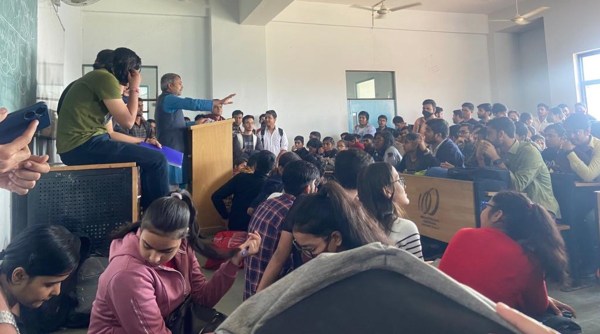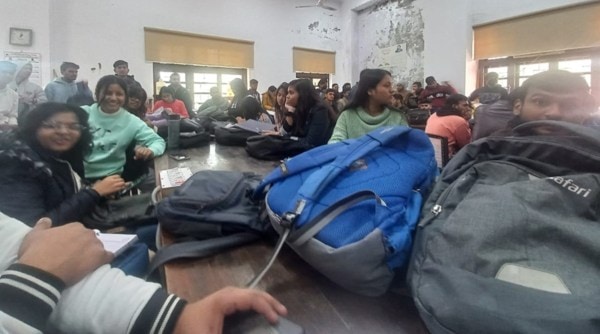Why Delhi University is bursting at the seams
To understand the challenges the university is facing, The Indian Express looked at four colleges and spoke to students, teachers and administrators.
 A persistent issue, it has come to the fore again after offline classes resumed post the Covid-induced lockdown and restrictions. (Representational/File)
A persistent issue, it has come to the fore again after offline classes resumed post the Covid-induced lockdown and restrictions. (Representational/File)Space constraints on campus, students asked to attend classes online, and a large number of students opting for the new Value Added Courses — several colleges at Delhi University are in dire need of expansion and better infrastructure to keep pace with their burgeoning student population.
A persistent issue, it has come to the fore again after offline classes resumed post the Covid-induced lockdown and restrictions.
To understand the challenges the university is facing, The Indian Express looked at four colleges and spoke to students, teachers and administrators.
Miranda House
A 15-acre campus, with gardens and well-ventilated and well-lit rooms, the Miranda House college campus in DU’s North Campus has around 4,000 and 75 classrooms. The building, which is around 70 years old, however, doesn’t have enough space in classrooms — a common complaint raised by students.
“If third-year students have an examination on a particular day, those in the first- and second-year are sent home or classes are taken online in some departments,” said Akshaya, a third-year BA student who hails from Kerala.
Similar concerns were raised by students from the physics department. “Two batches have been combined, so we have more than 100 people in a class. Four-five students sit in benches meant for three. It is very congested when everybody comes to class. At times, students prefer sitting on the floor as it’s difficult to ask questions from the back.”
When asked about issues flagged by students, principal Bijayalaxmi Nanda said, “For a public-funded institution, we are very fortunate to have the space that we have, but yes, we do have over-admission and we also have courses which are packed due to its popularity, so in terms of classroom size, we cannot predict… Expansion is always a good idea, but in terms of resources, we are doing quite good with what we have.”
 Miranda House Hostel at Delhi University New Delhi. (Express photo by Amit Mehra)
Miranda House Hostel at Delhi University New Delhi. (Express photo by Amit Mehra)
Nanda also highlighted that since some parts of the campus are deemed heritage areas, expanding vertically is a challenge. She said the idea of classrooms, however, is changing as the focus of Miranda House is to keep the carbon footprint down and not limit students to the idea of classrooms only in a concrete building.
Speaking to The Indian Express, college bursar Nandini Dutta flagged the challenges in adding more space. “Infrastructure is an ongoing issue given that the number of students who are entering our portals is increasing. There is always a demand for better facilities… Most colleges in DU are facing this issue… That doesn’t mean we don’t respond to newer demands… catching up might be slower because construction is not something that can be done overnight. But getting classrooms is just not adding another room, we need a whole host of permissions, we need funding.”
Zakir Husain Delhi College (morning and evening)
Zakir Husain, DU’s off campus college, is one of the oldest in Delhi and is in dire need of improvement of its infrastructural facilities. Some of the issues students raised were small classrooms, old desks, and an under-construction block.
“Evening classes in DU usually are between 2 and 7 pm, but due to infrastructural limitations, our classes have been taking place between 4 and 9 pm. The administration has told us our classes will go back to normal timing only when the new building opens,” said a second-year BA student.
A second-year BA philosophy student, who said his classroom strength is 100, said: “Whenever there is an examination for one batch of students, the other batches are sent home and classes are moved online. Many students hardly attend classes due to the lack of space.”

With classes running late into the evening, girl students also raised safety concerns. “I don’t feel safe attending classes which end around 9 pm, which is primarily because of space constraints,” said Nishta Singh, a third-year BA programme student.
There are around 10,000 students in the morning and evening college combined. “The new building still has some pending work to be done, but students have to choose Value Added Courses subjects which have a very high strength. More than 300 students have opted for the digital marketing and psychology courses. This is the first time that these courses have been introduced and we are still trying to figure out how to optimise. Our infrastructure is expanding, and as soon as our new building opens up, these problems will be resolved, hopefully in 5-6 months,” said Narender Singh, Principal, Zakir Hussain Delhi College (morning).
Ramjas College
At Ramjas College, which started in 1917 but moved to its present location in North Campus in 1950, students and teachers have flagged concerns regarding space. The college has a student strength of 5,000-6,000, with around 200 hostellers (boys and girls), and about 250 teachers.
“When offline classes resumed, I had come with tremendous expectations as it was my first time entering campus. On my second day of college, I sat on the floor during class. This was not the kind of classroom experience I had expected from a North Campus college,” said a third-year student.

Teachers too flagged issues with space, both in classrooms and the staff room. Tanvir Aeijaz, an associate professor in the political science department, said: “In the Value Added Course, a teacher has 300-400 students which is difficult to handle. If you increase workload, then you will also have to expand infrastructure. Classrooms are very small, they cannot accommodate more than 40-50. There is not enough space in the staffroom to accommodate teachers either.”
“I teach a class of 550 students for the VAC paper, Constitutional Values and Fundamental Duties. The classroom is built to accommodate 66. I divide the class in four and take four lectures, which ideally should be one lecture per week. Even in those 4 lectures, there were about 110 students per class, which is a problem. This also affects the quality of teaching,” said Dr Shailesh Kumar Diwakar, associate professor, Political Science, at the college.
The college has 90 classrooms and 33 labs, which are also used for teaching.
Speaking to The Indian Express, Principal Manoj Khanna said: “Right now, we are optimising resources… We are digitising the timetable so that we know which room is available at what time… Student strength was more than the capacity during the cut-off- based admission process. For example, if there were 100 students who met the 95% cut-off mark, even if our capacity was 70, we had to admit all. CUET will take care of this problem.”
He added: “An entire floor was under construction to increase the number of classrooms; it is almost ready.”
Hansraj College
At Hansraj College, classes are held in three blocks — A, B and C. Parts of C block are also under construction.
Here too, students flagged space constraints and claimed classes are held online during exams. “I have to walk 2 km to the DU geology department daily to attend lab classes as there is no space in the college campus,” said a second-year geology student.

Sharanya, a philosophy student associated with SFI, said: “First- and second-year students had online classes during third-year examinations as there was no space to hold them simultaneously. We spend so much money on finding accommodation in Delhi and then we find out that we have to attend classes online. Not everyone has good WiFi or devices to attend online classes. When we approached teachers, they said there is no space to accommodate all students.”
The college has a student strength of 5,000 and 61 classrooms. College principal, Dr Rama Sharma, however, said space and infrastructure were not a problem: “We have enough classrooms and three-four seminar rooms, but this time, due to the overflow of all 1st, 2nd and 3rd years together it might seem like we have a space crunch. Infrastructure is expanding and there is construction underway on campus.”
On the issue of moving to online classes Sharma said, “We don’t send students home, we have managed to hold all classes during exams. We can’t call this a problem, this is management as per the situation.”







